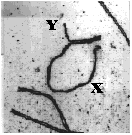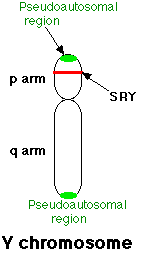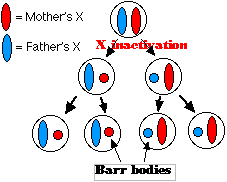
| see Making Transgenic Animals |
| Index to this page |
The nuclei of human cells contain 22 autosomes and 2 sex chromosomes. In females, the sex chromosomes are the 2 X chromosomes. Males have one X chromosome and one Y chromosome. The presence of the Y chromosome is decisive for unleashing the developmental program that leads to a baby boy.
In making sperm by meiosis, the X and Y chromosomes must separate in anaphase just as homologous autosomes do. This occurs without a problem because, like homologous autosomes, the X and Y chromosome synapse during prophase of meiosis I. There is a small region of homology shared by the X and Y chromosome and synapsis occurs at that region.

This image, courtesy of C. Tease, shows synapsis of the X and Y chromosomes of a mouse during prophase of meiosis I. Crossing over occurs in two regions of pairing, called the pseudoautosomal regions. These are located at opposite ends of the chromosome.

The pseudoautosomal regions get their name because any genes located within them (so far only 9 have been found) are inherited just like any autosomal genes. Males have two copies of these genes: one in the pseudoautosomal region of their Y, the other in the corresponding portion of their X chromosome. So males can inherit an allele originally present on the X chromosome of their father and females can inherit an allele originally present on the Y chromosome of their father.
This diagram shows the structure of the human Y chromosome.
Genes outside the pseudoautosomal regions
Although 95% of the Y chromosome lies between the pseudoautosomal regions, only 106 protein-encoding genes have been found here. Over half of this region is genetically-barren heterochromatin. Of the 106 genes found in the euchromatin, some encode proteins used by all cells. The others encode proteins that appear to function only in the testes. A key player in this latter group is SRY.
SRY (for sex-determining region Y) is a gene located on the short (p) arm just outside the pseudoautosomal region. It is the master switch that triggers the events that converts the embryo into a male. Without this gene, you get a female instead.
What is the evidence?
| see Making Transgenic Animals |
(In 1996, a test based on a molecular probe for SRY was used to ensure that potential competitors for the women's Olympic events in Atlanta had no SRY gene. But because of possibilities like that in case 4, this testing is no longer used to screen female Olympic athletes.)
| X | Y | |
|---|---|---|
| X | XX | XY |
| Xh | XhX | XhY |
Women rarely suffer from hemophilia because to do so they would have to inherit a defective gene from their father as well as their mother. Until recently, few hemophiliacs ever became fathers.
| Link to a pedigree of the descendants of Queen Victoria, a carrier for hemophilia B. |
| Link to a discussion of red-green colorblindness; another example of X-linked inheritance. |
Human females inherit two copies of every gene on the X chromosome, whereas males inherit only one (with some exceptions: the 9 pseudoautosomal genes and the small number of "housekeeping" genes found on the Y). But for the hundreds of other genes on the X, are males at a disadvantage in the amount of gene product their cells produce? With some exceptions (see below), the answer is no. This is because females have only a single active X chromosome in each cell.
During interphase, chromosomes are too tenuous to be stained and seen by light microscopy. However, a dense, stainable structure, called a Barr body (after its discoverer) is seen in the interphase nuclei of female mammals. The Barr body is one of the X chromosomes. Its compact appearance reflects its inactivity. So, the cells of females have only one functioning copy of most (see below) of the X-linked gene — the same as males.

X-chromosome inactivation occurs early in embryonic development. In a given cell, which of a female's X chromosomes becomes inactivated and converted into a Barr body is a matter of chance (except in marsupials like the kangaroo, where it is always the father's X chromosome that is inactivated). After inactivation has occurred, all the descendants of that cell will have the same chromosome inactivated. Thus X-chromosome inactivation creates clones with differing effective gene content. An organism whose cells vary in effective gene content and hence in the expression of a trait, is called a genetic mosaic.
Inactivation of an X chromosome requires a gene on that chromosome called XIST.
Of the approximately 800 genes on the X chromosome, it turns out that 15–25% of them continue to be expressed from the Barr body. How these genes escape inactivation remains to be discovered.
Included among these, are several tumor suppressor genes. This may account for the fact that cancer is more common in men than in women [Link]. As men have only a single X chromosome, they have only one copy of each of these tumor suppressor genes and thus a mutation in one of them would remove the brake on tumor formation. Women, with the gene expressed by both the active and inactive X chromosomes, would still have a functioning copy.
Although the male fruit fly, Drosophila melanogaster, is X-Y, the Y chromosome does not dictate its maleness but rather the absence of a second X. Furthermore, instead of females shutting down one X to balance the single X of the males — as we do — male flies double the output of their single X relative to that of females.
In birds, moths, schistosomes, and some lizards, the male has two of the same chromosome (designated ZZ), whereas the female has "heterogametic" chromosomes (designated Z and W). In chickens, a single gene on the Z chromosome (designated DMRT1), when present in a double dose (ZZ), produces males while the presence of only one copy of the gene produces females (ZW).
The choice is usually determined by the temperature at which early embryonic development takes place.
Even in cases (e.g. some lizards) where there are sex chromosomes, a high temperature can convert a genotypic male (ZZ) into a female.
Hermaphrodites have both male and female sex organs. Many species of fish are hermaphroditic.
Some start out as one sex and then, in response to stimuli in their environment, switch to the other.
Other species have both testes and ovaries at the same time (but seldom fertilize themselves). (However, populations of C. elegans consist mostly of hermaphrodites and these only fertilize themselves — Link to a discussion.)
Hermaphroditic fishes have no sex chromosomes.
| Welcome&Next Search |